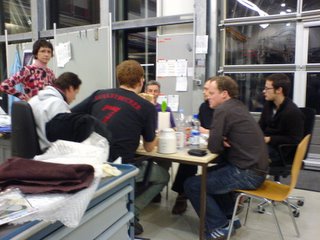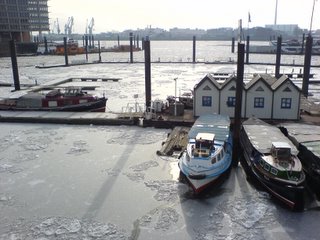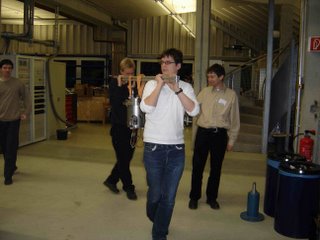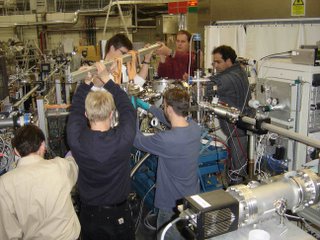Antons comment:
"If we insert the LLNL imaging can in the system, could the experiment run with the beam off-centre? This could be done by swapping in a new front flange with an offset (slightly higher) beam entry port and lowering the whole chamber. Of course, we would need enough travel in the chamber support system to accomodate this (not a bad idea in the first place, to be able to place the FEL beam anywhere in the chamber). Plus it would be a good idea to have pitch and yaw control over the chamber itself (perhaps manual by turning screws, perhaps a 6-strut system?)"
the off-axis is a good idea, why did i not think of that option?
i have had a first contact with minitec in sweden today. unfortunately, they cannot provide us a micron positioning system. so we have to find something else.
2006–2007 var detta en teknisk blogg, bl.a. om en vacuumkammare. 2008–2013 var temat idépolitik, främst ekonomisk demokrati. 2017–2018 var det en dagbok från Uppsalas plan- och byggnadsnämnd. Nu: Basemba – riffrock med ruff.
2006-02-22
2006-02-21
and the winner is... solidworks
we need to have full cad compartibility, either with llnl or tub, so we have decided to go for solidworks. it will be running in a few days.
2006-02-20
future of the blog

i leave hamburg for uppsala tomorrow. anyhow, i will continue this blog, now mainly with focus on the chamber. you are always welcome to email me, but if you feel that the info suits for the blog, you can comment on any given post. i would like this blog to be a forum for uppsala, llnl, berlin, hamburg,... i expect instant feedback if i should fail in judgement for what should be on the internet or not. when i post info of major interest, i will always send a notice email to the ones concerned. the blog has the main advantage that i do not have to send big attachments to a lot of people.
input from moellers
requests for the chamber, based on the alfa.2 version:
1) the top flange: preferably 250 (as the top flange now), or 200
2) main side flange: preferably 250 (as now), or 200
3) top, bottom and side flanges lined up
-the chamber base will be minitec based. minitec also provides servo motors for positioning. minitec is modular, so the cluster source can be mounted on minitec in berlin, and then mounted on the base in hamburg.
-if we make the two sets of: top, two side, and bottom flanges equal, and put the distance from the beamline side to the centre of the first set of flanges to 200mm, the centre distance between the two sets of flanges to 400mm, and the second set of flanges to 400mm from the rear side flange, i.e. from the side:
| 200 O 400 O 400 |
then we have the option to set the experiment 200, 400 (swap beamline and rear sides), 600 (200+400) or 800 (swap again, 400+400) mm from the beamline flange. that provides space for e.g. a delay device, apertures, or refocusing optics.
-a generous amount of 40, 60, ... viewports and feedthrough flanges on different geometries.
tp (experimentalist edition) knowledge: up to 200 (8 inch) there is one worldwide standard, 250 (10inch) and upwards have different standards.
1) the top flange: preferably 250 (as the top flange now), or 200
2) main side flange: preferably 250 (as now), or 200
3) top, bottom and side flanges lined up
-the chamber base will be minitec based. minitec also provides servo motors for positioning. minitec is modular, so the cluster source can be mounted on minitec in berlin, and then mounted on the base in hamburg.
-if we make the two sets of: top, two side, and bottom flanges equal, and put the distance from the beamline side to the centre of the first set of flanges to 200mm, the centre distance between the two sets of flanges to 400mm, and the second set of flanges to 400mm from the rear side flange, i.e. from the side:
| 200 O 400 O 400 |
then we have the option to set the experiment 200, 400 (swap beamline and rear sides), 600 (200+400) or 800 (swap again, 400+400) mm from the beamline flange. that provides space for e.g. a delay device, apertures, or refocusing optics.
-a generous amount of 40, 60, ... viewports and feedthrough flanges on different geometries.
tp (experimentalist edition) knowledge: up to 200 (8 inch) there is one worldwide standard, 250 (10inch) and upwards have different standards.
2006-02-19
moeller lunch at 1am
2006-02-17
cad program for macintosh?!
i would like _very much_ to work on my mac laptop. neither solidedge (hasylab, moller group) or solidworks (livermore) have mac versions.
i did find a 3D modeling program, for both mac and pc by googling:
amapi
matthias hoener from the moller group thinks it looks good on the homepage. it is compartible with solidedge and solidworks. they would be willing to switch program (from solidedge) to be compartible with us.
i did find a 3D modeling program, for both mac and pc by googling:
amapi
matthias hoener from the moller group thinks it looks good on the homepage. it is compartible with solidedge and solidworks. they would be willing to switch program (from solidedge) to be compartible with us.
experiment in uppsalachamber
alfa.2: matthias hoeners version

matthias hoener, a phd student in möllers group, made this draft.
-it is a tube (not square) chamber: better for pumping, cheaper, stands the 1atm vs. high vacuum force better.
-it has the advantages of the square chamber:
1) square removable top providing good access.
2) with the two supports with (not included in the drawing) windings, experiments on a base can easily be mounted.
-viewports can be mounted on reduction flanges on the front and back.
2006-02-14
uppsalachamber, cont.
i will go for hamburg tomorrow wednesday. the möllers still have beamtime, and they are part of the uppsalachamber project. let's see what they think of our proposal, see link below. i will learn how to use solidedge, a cad-program.
uppsalachamber: first draft
marvin seibert found a chamber on ebay:
ebay chamber
quote marvin: Hej Florian, there is a complete vacuum chamber up for sale on ebay. Looks like a diving bell and comes complete with pumps. Just for fun...
uppsalachamber: first draft
marvin seibert found a chamber on ebay:
ebay chamber
quote marvin: Hej Florian, there is a complete vacuum chamber up for sale on ebay. Looks like a diving bell and comes complete with pumps. Just for fun...
2006-02-08
last post for this beamtime
i am about to leave for uppsala. i will miss the pumpnprobe the next two days, i guess we will hear all about that anyway. to conclude, we were very lucky with the beam these weeks, apparently, the vuv-fel has never been running so well. quote henry chapman: "As for our experiment, we slam dunked it, we kicked the ball up the field against the wind, we hit a hole in one, we put the pedal to the metal, and we scored a six, a home run, and hung ten on the pipe."
end of confusion
for the last three shifts starting 7am today, ending 7pm on friday, we originally intended to perform pump&probe experiments, with a multilayer mirror mounted on the rear side of the latex balls.
our original plan was to use a 2nd harmonic: 16nm mirror, but our experience with 2nd harmonic measurements was not convincing. so we decided to use the fundamental wavelength, but the required mirror was in livermore. but fedex lost it: no-we-have-not-lost-it-we-just-do-not-know-where-it-is. so we had to give up on doing pump&probe today, instead we do regular scattering experiments on focussed ion beam (fib) structures and latex balls. urs, a swiss postdoc at livermore, is on a plane to germany, to deliver spare 32nm mirrors. he will arrive tonight in hamburg. so we will at least have two shifts of pumpnprobe experiments.
marvin from uppsala volunteered to get on the first flight this morning to get to san fransisco. he celebrated with champagne when urs could do it instead.
our original plan was to use a 2nd harmonic: 16nm mirror, but our experience with 2nd harmonic measurements was not convincing. so we decided to use the fundamental wavelength, but the required mirror was in livermore. but fedex lost it: no-we-have-not-lost-it-we-just-do-not-know-where-it-is. so we had to give up on doing pump&probe today, instead we do regular scattering experiments on focussed ion beam (fib) structures and latex balls. urs, a swiss postdoc at livermore, is on a plane to germany, to deliver spare 32nm mirrors. he will arrive tonight in hamburg. so we will at least have two shifts of pumpnprobe experiments.
marvin from uppsala volunteered to get on the first flight this morning to get to san fransisco. he celebrated with champagne when urs could do it instead.
2006-02-06
uppsalachamber alfa.1: first draft

the dark-shadowed flange ports are 300mm (12 inch) large.
antons wishlist:
-2xDiagonal (45 deg) VP for looking at alignment HeNe on sample
-Good light-tight shutters for keeping dark signal low on CCD
-Space for 90 degree mirror arrangement (LLNL imaging mode)
-Plenty of pumping for particle injection experiments
-Front end could have focussing optic, or
-Differential pumping stage on front end to allow chamber to run at higher pressure?
24h shift: 30 degrees measurement

we will use this 24h shift (ending monday at 7pm) for the 30 degrees camera&mirror setting, so we can see the elastic scattering minimum around <30 degrees, see mie scattering simulations.
time for carrot juice!
2006-02-05
network
göstas comments:
We now have a private wireless network through which we should be able to reach our data. Ask Gösta for the details of connecting.
One _should_ be able to see shared folders in our data computer
by enabling Windows Sharing on the Mac (System
Preferences -Sharing) and then using Finder-Go-Connect to server). After
some hassle, we got this to work for Florian. If you don't know the server address, ask someone.
You can ssh and such to our data computers local address. I still can't make recursive scp or rsync work (think sftp works). On the other hand, now that we are on the same network you can
log on to the data computer and rsync back to your computer. In that direction it
works, for me at least.
The wireless printer is connected to our private network, you can't use it from the public network anymore. Printing with the USB cable hasn't changed.
We now have a private wireless network through which we should be able to reach our data. Ask Gösta for the details of connecting.
One _should_ be able to see shared folders in our data computer
by enabling Windows Sharing on the Mac (System
Preferences -Sharing) and then using Finder-Go-Connect to server). After
some hassle, we got this to work for Florian. If you don't know the server address, ask someone.
You can ssh and such to our data computers local address. I still can't make recursive scp or rsync work (think sftp works). On the other hand, now that we are on the same network you can
log on to the data computer and rsync back to your computer. In that direction it
works, for me at least.
The wireless printer is connected to our private network, you can't use it from the public network anymore. Printing with the USB cable hasn't changed.
mounting of filter sample
2006-02-04
michail yurkov visiting the experiment


michail yurkov, the main man for the vuv-fel machine, was visiting our experiment this morning. the said that they do not understand the 2nd harmonic (16nm) radiation, it should not be there. and it can not be controlled or optimized. in contrast, the 3rd harmonic at 11nm is well understood. in the future, we should therefore aim for the 3rd harmonic.
later today, i got a 10 minute lecture of evgeny l. saldin, who invented self-amplified spontaneous emission, sase, at the age of 23 in the early eighties. i am generous enough to share my new expertise.
connecting to mie computer
Göstas comments:
We know have a Desy account that should let us log in to any Windows or Unix
computer here. Ask around for the username and password.
There is also an ssh/scp/sftp server on the data computer. Unfortunately you
cannot connect directly to the data computer unless you are hooked up to the
internal network. Here is a work around:
1)
Add the following line to your /etc/hosts file
(C:\WINDOWS\system32\drivers\etc\hosts on WinXP):
127.0.0.1 mie
2)
Open an ssh tunnel to bastion.desy.de:
ssh -l vuvupp -L 22:hasbl2mie.desy.de:22 bastion.desy.de
3)
As long as this tunnel is alive, you should be able to connect to our data
computer with ssh/scp/stp, using the alias mie for the host name. For
example, ssh username@mie. Ask around for the username and password.
We know have a Desy account that should let us log in to any Windows or Unix
computer here. Ask around for the username and password.
There is also an ssh/scp/sftp server on the data computer. Unfortunately you
cannot connect directly to the data computer unless you are hooked up to the
internal network. Here is a work around:
1)
Add the following line to your /etc/hosts file
(C:\WINDOWS\system32\drivers\etc\hosts on WinXP):
127.0.0.1 mie
2)
Open an ssh tunnel to bastion.desy.de:
ssh -l vuvupp -L 22:hasbl2mie.desy.de:22 bastion.desy.de
3)
As long as this tunnel is alive, you should be able to connect to our data
computer with ssh/scp/stp, using the alias mie for the host name. For
example, ssh username@mie. Ask around for the username and password.
2006-02-03
visits

yesterday, sebastiens wife was around. and so was marvin seibert, a phd student from our group in uppsala. he did not disappoint us, and brought a bag full of choclate.
and the beamline from now on has its own saint. let me introduce zé, the flamengista.
the people here now are: sebastien, mike, stefano, henry and anton from llnl, janos, magnus, gösta, calle, ricardo and me from uppsala.

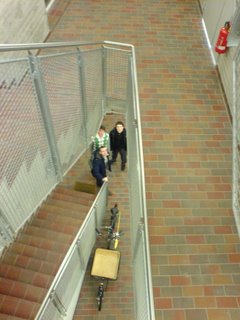
2006-02-01
fast shutter
the fast shutter has a shutter lifetime of 10000 shots (VERY limited, not sufficient for even a single beamtime, and we are a few user groups who need it). the vuv-fel crew are working on a shutter with a longer lifetime.
the shutter is seen in the photo. on the top of the chamber, a dc motor controls a shutter made of graphite, which is mounted through the dark bellow on the top flange.
there are three commmands for the shutter, operated from the vuv-fel software doocs: closed, open and click, i.e. it opens for a single shot. for this beamtime we will work with a manual control of the fast shutter. the staff is afraid of the possibility that our labview program will make it too easy for us to shoot of the 10000 precious events.
now anton has programmed it so that if we want to take a ccd image
1) for a single shot:
a) close shutter in doocs
b) start exposure in labview
c) click shutter in doocs
d) exposure will close automatically (exposure time predefined in labview)
2) over many shots:
a) start exposure in labview
b) open shutter in doocs
c) exposure will close automatically (exposure time predefined in labview)
the shutter is seen in the photo. on the top of the chamber, a dc motor controls a shutter made of graphite, which is mounted through the dark bellow on the top flange.
there are three commmands for the shutter, operated from the vuv-fel software doocs: closed, open and click, i.e. it opens for a single shot. for this beamtime we will work with a manual control of the fast shutter. the staff is afraid of the possibility that our labview program will make it too easy for us to shoot of the 10000 precious events.
now anton has programmed it so that if we want to take a ccd image
1) for a single shot:
a) close shutter in doocs
b) start exposure in labview
c) click shutter in doocs
d) exposure will close automatically (exposure time predefined in labview)
2) over many shots:
a) start exposure in labview
b) open shutter in doocs
c) exposure will close automatically (exposure time predefined in labview)
bicycle at the vuv-fel
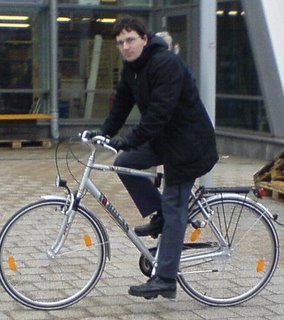
i have bought a bike of brand bocas which everybody can use here in hamburg. if you want to use it when we are not here, ask thomas tschentscher.
good news
the multilayer mirror is working. the camera is working. the fel is working. we are working. quite successfully!
Subscribe to:
Posts (Atom)
